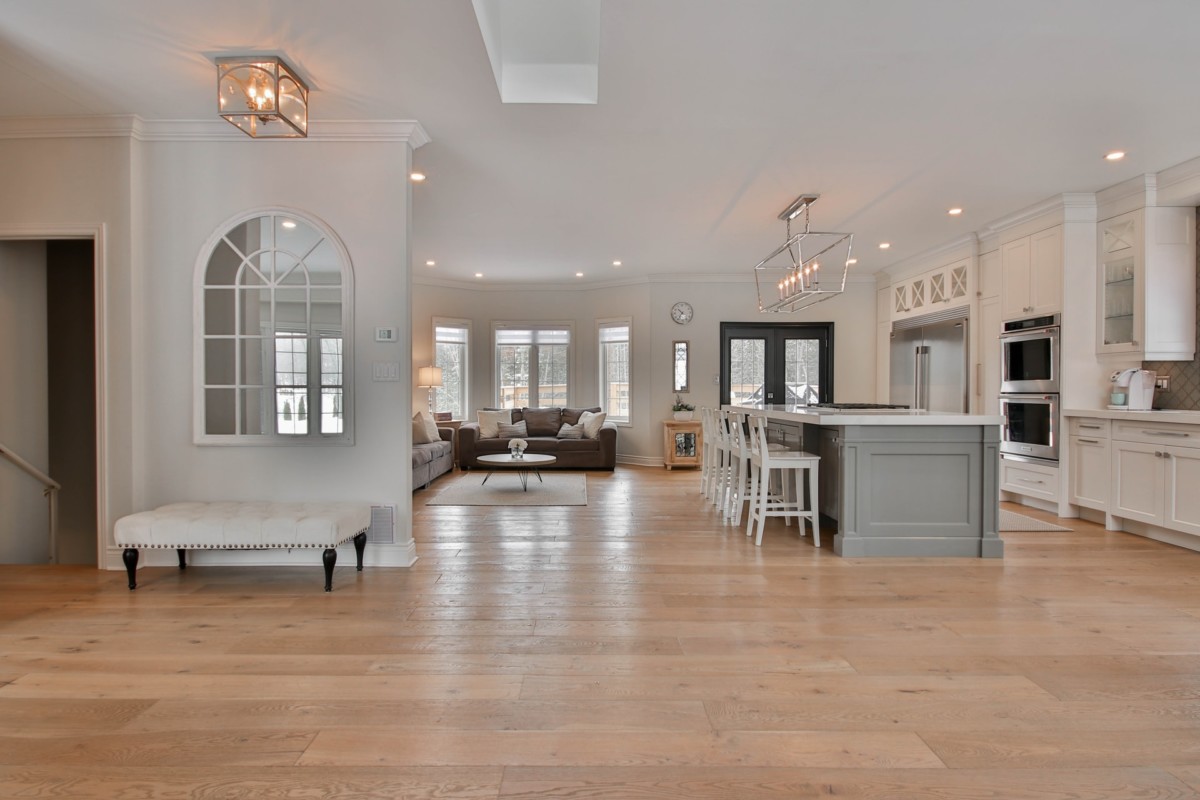Picture this – it’s a chilly winter morning and when you step into your kitchen to make yourself a cup of coffee, your bare feet are warmed by the floor beneath you. Sounds nice, doesn’t it? Heated floors are a great alternative to traditional heating methods. They can keep your home, and your toes, warm all winter. So whether you are planning your next home remodel in Cincinnati, OH, or considering buying a home with heated floors in Toronto, CA, here is everything you need to know when deciding if heated flooring is the right choice for your home.

What are heated floors?
Heated floors, also known as radiant heating, are a type of heat system that is located underneath the flooring of the home. The warmth rises evenly from below via heat radiation. And the temperature of the room is uniform from top to bottom, rather than hot air rising from forced-air systems. Although expensive to install upfront, this efficient way of heating is a great alternative to traditional heating methods and may be worthwhile for your household in the long run.
Pro tip:
When cleaning heated floors, you’ll want to be cautious of the heating system element. Avoid excess water, use neutral cleaners and be especially careful around seams or edges where moisture has the ability to seep through. – Advanced Floor Cleaning
Renovating your home?
Find out what your home's worth, edit facts, and see the impact of home projects.
What are the different types of heated floors and how do they work?
Renovating your home?
There are two types of radiant floor heating systems: hydronic and electric.
- Hydronic radiant floor heating: With this type of radiant heating system, hot water is generated from a boiler, which is then pumped throughout the floors via tubes. These pipes snake throughout the flooring, radiating thermal energy through materials like tiles, concrete, or wood. Hydronic heating is more efficient than conventional heating and works best at heating larger areas. They are more typical for whole-house installations rather than room by room. Since hydronic systems require additional parts like a boiler and a pump, the upfront cost of installation can be expensive. However, you can save up to 30% more in operating costs compared to conventional heating systems.
- Electric radiant floor heating: This type of radiant heating system is powered by electric wires located underneath the flooring. Due to the cost of electricity, warming an entire home with electric radiant heating can quickly become expensive. Therefore, this method is most popular for heating individual rooms, such as a bathroom or bedroom, rather than the whole house. Electric installations heat up floors in about 30-60 minutes. Set a schedule to heat your floors in the morning with specific hours – or whenever you need it.
Pro tips:
Hydronic heating systems use flexible “PEX” tubing to disperse floor heating throughout the home. While the tubing generally does not require upkeep, regular maintenance on pumps and boilers may extend the longevity of a radiant floor heating system. Damaged pumps should be repaired quickly to prevent potentially costly damage to other parts of the radiant floor heating system. With minimum essential maintenance, a radiant floor heating system can keep your concrete floors comfortably heated for up to 100 years. – Craftsman Concrete
For homeowners in areas where things like geological heating, hydronic heating, or other methods may not work or be easily accessible. A versatile method for heating your floors is using the Schluter Systems DITRA-HEAT floor heating system. It can be installed by a flooring professional and requires a simple electrical hookup. For areas like Tampa Bay, where we work, this is by far the simplest and most effective way. – Home Love Construction
How much does it cost to install?
When it comes down to price, hydronic solutions are a more cost-effective alternative in the long run. This is because the operating costs are lower than electric systems. This is because the water conducts and holds heat more efficiently which lowers the operating time. Hydronic heating systems range from $6-$20 averaging at $13 per square foot for professional installation. Electric ranges from $8-$15 averaging at $11 per square foot.
Electric radiant floor systems are cheaper to install because they use electrical wire mats. They also do not require additional parts that hydronic systems demand. The rate of installation can vary based on a number of factors. For example, if you already have a boiler or a water heater and the floors are already opened, it will be easier for plumbers to install the heating system. If you are remodeling your home and need to open the floors for install, that will add to the cost of installation. If you have some experience wiring and installing pipework, then a DIY radiant floor heating can cut your prices down significantly.
Pro tips:
Hire a smaller flooring business company for materials and installation projects. You will save more money hiring a smaller company than a big corporation. This is because there’s more corporate overhead the company has to pay out of pocket. Smaller companies can work with your budget. Try to stick with a one-man shop to purchase your materials and do your installation. You will save more money having one company do the job than having multiple vendors and contractors during the project. Reasons why include transaction fees, handling fees, delivery fees, and sales taxes that will add up. – Decades Flooring
Be sure to budget for an electrician. A certified electrician is almost always needed to connect your installation to your home’s electrical system as well as connect a thermostat, and make sure that your home’s existing wiring and electrical infrastructure will support your new addition. – Enhance Floors & More

What are the advantages and disadvantages of radiant floor heating?
Advantages
-
- Silence: When compared to air forced systems, there is little to no noise with radiant floor heating systems. This is because there isn’t a furnace that turns on and/or vents to push the warm air out.
- Non-allergenic: Radiant floor heating systems depend on conduction throughout the home through systems in the floors and walls. Allergies lessen since there are no vents or ducts which circulate allergens.
- Energy efficiency: Without ducts and vents required for the warm air to circulate, radiant heating is much more efficient in keeping your home warm. Traditional heating systems can leak warm air through ducts. This forces you to keep the heat on for longer periods of time.
- Consistent heat: Heated floors radiate heat to objects in a room, and because of this, the air temperature stays consistent throughout the areas of your home rather than rising to the ceiling.
- Maintenance: Minimal maintenance is required for radiant flooring and most companies that install this type of heating system offer a minimum of a 25-year warranty.
Disadvantages
- Cost: The costs of radiant floor heating systems overall are dependent on the size of the project and which type of system you opt for. Installation can be expensive when compared to forced air systems – especially if you’re remodeling an existing home. Radiant heating is more affordable once installed in one or two rooms. The bathroom is always a popular choice.
- Installation: If you’re retrofitting an existing home that currently has a forced-air system, the process of installing radiant heating requires removing the existing flooring so the systems can be put in place, all of which will be costly. For new construction, see if your contractor can work within your budget to install radiant heating throughout your new home.
Pro tips:
One of the great advantages of radiant floor heating is ‘zoning’. This feature allows you to heat an area of your home separately. Make your living room a bit warmer, your bedroom cooler, and turn down rooms that are not being used. You’ll not only optimize the comfort for every occupant, but you’ll also help save a significant amount on your energy bill. – Warmboard
It is important to recognize the health benefits of a radiant system. Radiant heat is clean, comfortable, and consistent. We create a healthy, comfortable home environment without having to rely on frequently circulating air. While ventilation is important, with radiant heat, you are less exposed to dirt, dust, allergens, viruses, which allows us to design and create a healthier living space. – JM Engineering
Combining radiant floor heating with a forced hot air system can deliver the best heating system for your house. You’ll get the coziness of warm floors, with the ability to easily change the temperature without waiting hours. Plus, you’ll have the ductwork for central cooling as well. – FuelSnap
Looking to save money on your mortgage?
What types of flooring are best for radiant floor heating systems?
There are many different types of flooring options compatible with radiant floor heating systems. Which one is the most efficient? The most common materials to use with heated flooring are ceramic and stone tile. Vinyl and linoleum, wood, or carpeting are other popular flooring materials. If any flooring material has too high of a degree of insulation, your heating system will be less effective.
So whether you are ready to start your next remodeling project, or looking for houses with heated flooring as a home feature, consider everything that goes into radiant heating so you can choose the best option that fits your needs and keeps you warm and cozy all year round.



























 United States
United States Canada
Canada